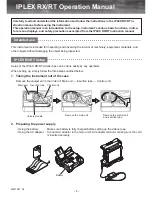
Chapter 3, Getting Started with Xgig TraceControl
Xgig Tuning and Equalization
72
Xgig Analyzer User’s Guide
Press
Reset
to refresh the web page to the currently stored settings.
Restore Equalization Defaults
To restore the original factory equalization settings, press the
Restore defaults
button. The restore
process will automatically apply the factory default Equalization settings and the latest Tuning
results at the end of the Tuning process.
Technical Overview of Tuning and Equalization
Given the challenge of extreme serial bit rates for 6.0Gbps SAS/SATA and the state of current
6.0Gbps SAS/SATA components, manual Equalization and Tuning procedures are required to
ensure that you receive reliable results. These procedures may become unnecessary in the future as
SAS-2 devices evolve and signal quality and jitter issues are resolved, but at present they are the
best way to achieve optimal results.
Tuning is used to fine-tune the sampling position in the data stream. In addition to the intrinsic
parasitics found in a copper channel, there are additional interoperability challenges with the high
serial bit rates for 6.0Gbps SAS/SATA. These include jitter sources, transmitter voltage levels, and
slew rate, to name a few. A user-initiated tuning function optimizes the Xgig ports for the
particular devices and channel in use. The tuning process maximizes the receiver margin to ensure
signal interoperability.
The copper channel used in SAS/SATA, consisting of traces, vias, connectors, and cables, has
low-pass filter characteristics. This means higher-frequency components in the serial bit stream
will have their voltage amplitude attenuated in comparison to low-frequency components in a
pattern. To compensate for this phenomenon, the SAS-2 specification requires the use of
de-emphasis at the transmitter and equalization at the receiver. De-emphasis reduces the
low-frequency signal. Equalization attempts to correct any lingering differences between high and
low frequencies at the signal destination.
Equalization is required for all SAS-2 devices; however, most current SAS-2 devices, including
the current version of the 6G SAS/SATA blade or system, do not have auto-equalization circuitry.
This means that equalization settings are selected for the ports when the blade is shipped, and the
settings need to change based on the environment they are used in. The primary variables for
setting equalization are the length of the cables and amount of de-emphasis from the source.
See Figure 32 for contrasting examples showing how Equalization is required to ensure signal
integrity when there is no de-emphasis. The first example shows no de-emphasis at the source,
signal degradation, and the need for a moderate equalization setting to ensure signal integrity. The
second example shows how de-emphasis at the source can eliminate the need for changing the
Equalization setting. See Figure 33 for an example of how the use of long cables slightly increases
the need for Equalization.
Summary of Contents for Xgig
Page 1: ...Xgig Analyzer Version 7 3 User s Guide ...
Page 2: ......
Page 3: ...Viavi Solutions 1 844 GO VIAVI www viavisolutions com Xgig Analyzer Version 7 3 User s Guide ...
Page 6: ...Xgig Analyzer User s Guide Page iv Version 7 3 December 2015 ...
Page 7: ...v CONTENTS ...
Page 15: ...1 PART ONE Using Xgig Analyzer ...
Page 16: ...PART ONE Using Xgig Analyzer 2 Xgig Analyzer User s Guide ...
Page 27: ...13 PART TWO Using Xgig TraceControl ...
Page 28: ...PART TWO Using Xgig TraceControl 14 Xgig Analyzer User s Guide ...
Page 29: ...15 Chapter 2 About Xgig TraceControl In this chapter Introduction to TraceControl ...
Page 176: ...Chapter 6 Xgig TraceControl Hints and Tips Keyboard Shortcuts 162 Xgig Analyzer User s Guide ...
Page 177: ...163 PART THREE Using Xgig Performance Monitor ...
Page 178: ...PART THREE Using Xgig Performance Monitor 164 Xgig Analyzer User s Guide ...
Page 223: ...209 PART FOUR Using Xgig TraceView ...
Page 224: ...PART FOUR Using Xgig TraceView 210 Xgig Analyzer User s Guide ...
Page 225: ...211 Chapter 11 About Xgig TraceView In this chapter Introducing Xgig TraceView ...
Page 382: ...Chapter 15 Xgig TraceView Histograms Histogram Controls 368 Xgig Analyzer User s Guide ...
Page 383: ...369 Chapter 16 Xgig TraceView Template Editor In this chapter Using Template Editor ...
Page 437: ...423 PART FIVE Using Xgig Expert ...
Page 438: ...PART FIVE Using Xgig Expert 424 Xgig Analyzer User s Guide ...
Page 442: ...Chapter 21 Xgig Expert 428 Xgig Analyzer User s Guide Figure 194 Xgig Expert Graph View ...
Page 443: ...429 PART SIX Appendices ...
Page 444: ...PART SIX Appendices 430 Xgig Analyzer User s Guide ...
Page 454: ...Appendix C Protocol Display Color Coding 440 Xgig Analyzer User s Guide ...
Page 461: ...447 INDEX ...
Page 467: ......
















































